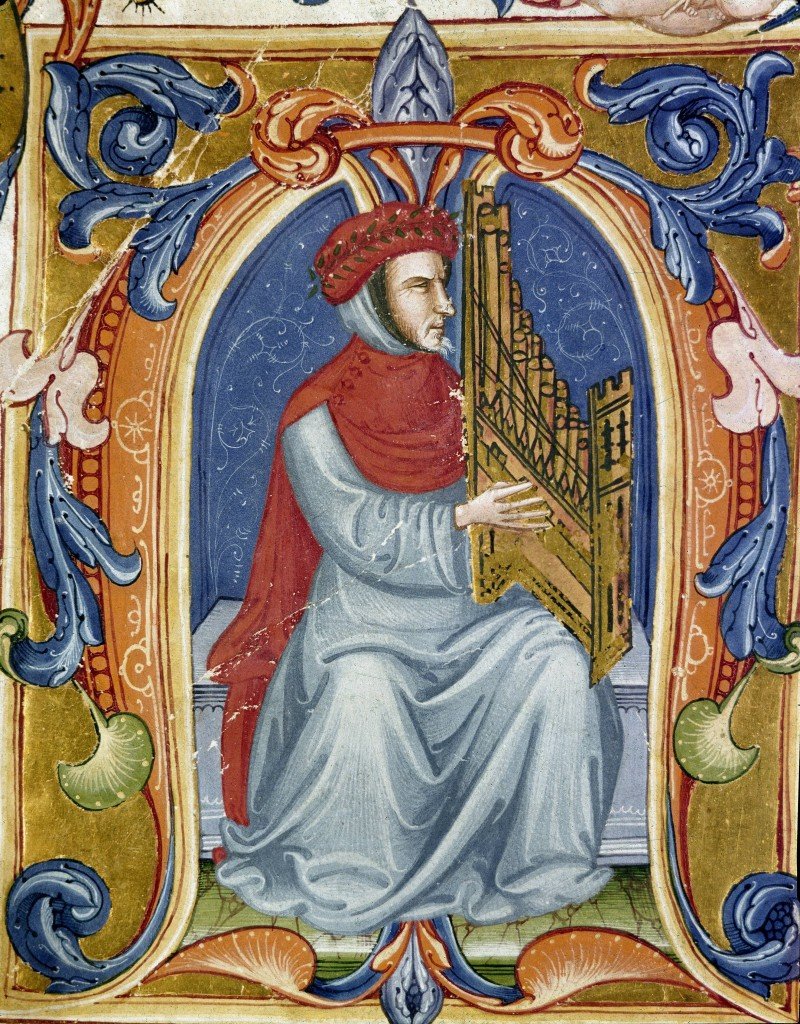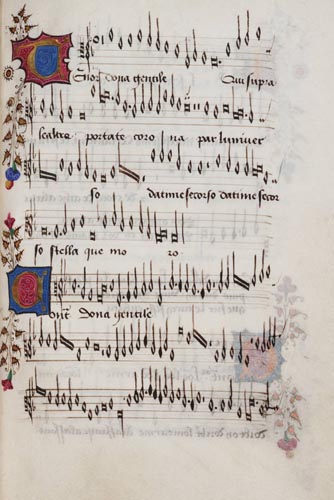
Musicians playing the Spanish vihuela, one with a bow, the other plucked by hand in the Cantigas de Santa Maria of Alfonso X of Castile, 13th Century.
The vihuela is fretted plucked string instrument shaped like a guitar, but tuned similar to a lute and the Cantigas de Santa Maria is a collection of poems with musical notations written during the reign of Alfonso X of Castile. The collection is considered one of the largest of solo songs from the Middle Ages and mentions the Virgin Mary in song.

A illustration detail of Francesco Landini playing an organetto in Squarcialupi Codex, 15th Century.
Francesco Landini was an Italian composer, poet, organist, singer and instrument maker. A secular composer, he was a prominent figure in the Trecento period of Italian cultural history. Landini is the eponym of the Landini cadence (or Landino sixth), a cadential formula whereby the sixth degree of the scale (the submediant) is inserted between the leading note and its resolution on the tonic. However this cadence neither originated with him, nor is unique to his music; it can be found in much polyphonic music of the period, and well into the 15th century.

Etching of William Byrd by Gerard Vandergucht, undated.
William Byrd was an English Composer of late Renaissance music. He wrote in many music forms including sacred and secular polyphony, keyboard, and consort (ensemble). He composed sacred music for Anglican services and, after converting later in life, Roman Catholic. Having grown up in an age in which Latin polyphony was largely confined to liturgical items for the Sarum rite, he assimilated and mastered the Continental motet form of his day, employing a highly personal synthesis of English and continental models. Byrd's output of about 470 compositions amply justifies his reputation as one of the great masters of European Renaissance music.

A portrait of Adrian Willaert by an unidentified painter, 1527.
Adrian Willaert was a Flemish composer of the Renaissance and founder of the Venetian School. He was prominent member of the generation of northern composers who moved to Italy and transplanted the polyphonic Franco-Flemish style there. Willaert was one of the most versatile composers of the Renaissance, writing music in almost every extant style and form. With his contemporaries, Willaert developed the canzone (a form of polyphonic secular song) and ricercare, which were forerunners of modern instrumental forms

A page from the Mellon Chansonnier prepared for the wedding of Catherine of Aragon, c. 1470.
With the advent of the printing press in 1450, production of printed music would soon follow with Ottaviano Petrucci producing the first collection of polyphonic music printed entirely from movable type in 1501. This technological breakthrough not only allowed for increased production of notated music, but changed the economics of the music artform. People had always played music to entertain themselves, but now it could be done with notated music.

